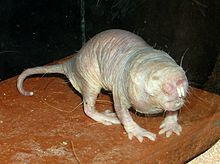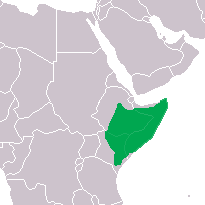
Back فأر الخلد العاري Arabic فار الخلد العارى ARZ Heterocephalus glaber AST Elmibol (Heterocephalus glaber) AVK Гол земекоп Bulgarian নেকেড মোল ইঁদুর Bengali/Bangla Razh-goz noazh Breton Rata talp nua Catalan Heterocephalus glaber CEB Rypoš lysý Czech
| Naked mole-rat | |
|---|---|

| |
| Scientific classification | |
| Domain: | Eukaryota |
| Kingdom: | Animalia |
| Phylum: | Chordata |
| Class: | Mammalia |
| Order: | Rodentia |
| Parvorder: | Phiomorpha |
| Family: | Heterocephalidae Landry, 1957[4][5] |
| Genus: | Heterocephalus Rüppell, 1842[3] |
| Species: | H. glaber
|
| Binomial name | |
| Heterocephalus glaber | |

| |
| Distribution of the naked mole-rat | |
The naked mole-rat (Heterocephalus glaber), also known as the sand puppy,[6] is a burrowing rodent native to the Horn of Africa and parts of Kenya, notably in Somali regions. It is closely related to the blesmols and is the only species in the genus Heterocephalus.[7]
The naked mole-rat exhibits a highly unusual set of physiological and behavioral traits that allow it to thrive in a harsh underground environment; most notably its being the only mammalian thermoconformer with an almost entirely ectothermic (cold-blooded) form of body temperature regulation,[8] as well as exhibiting a complex social structure split between reproductive and non-reproductive castes, making it and the closely related Damaraland mole-rat (Fukomys damarensis) the only widely recognized examples of eusociality (the highest classification of sociality) in mammals.[9][10] The naked mole-rat lacks pain sensitivity in its skin, and has very low metabolic and respiratory rates. It is also remarkable for its longevity and its resistance to cancer and oxygen deprivation.
While formerly considered to belong to the same family as other African mole-rats, Bathyergidae, more recent investigation places it in a separate family, Heterocephalidae.[5][11][12]
- ^ "Heterocephalus glaber". Mammalian Species. 26 December 2002. doi:10.1644/0.706.1.
- ^ Maree, S. & Faulkes, C. (2016). Heterocephalus glaber. The IUCN Red List of Threatened Species 2016 (errata version published in 2017). doi:10.2305/IUCN.UK.2016-3.RLTS.T9987A22184136.en
- ^ a b Cite error: The named reference
Ruppell1842was invoked but never defined (see the help page). - ^ Cite error: The named reference
Landrywas invoked but never defined (see the help page). - ^ a b Patterson BD, Upham NS (November 2014). "A newly recognized family from the Horn of Africa, the Heterocephalidae (Rodentia: Ctenohystrica)". Zoological Journal of the Linnean Society. 172 (4): 942–963. doi:10.1111/zoj.12201.
- ^ Kingdon J (1 July 1984). East African Mammals: An Atlas of Evolution in Africa, Volume 2, Part B: Hares and Rodents. University of Chicago Press. p. 489. ISBN 978-0-226-43720-0.
- ^ Cite error: The named reference
Buffenstein Park Hanes Artwohl 2012 pp. 1055–1074was invoked but never defined (see the help page). - ^ Welsh J (2011-10-12). "Naked Mole Rat Genome May Hold Key to Long Life". Human Health & Longevity. LiveScience. Retrieved 2013-03-23.
- ^ O'Riain MJ, Faulkes CG (2008). "African Mole-Rats: Eusociality, Relatedness and Ecological Constraints". In Korb J, Heinze J (eds.). Ecology of Social Evolution. Springer. pp. 207–223. doi:10.1007/978-3-540-75957-7_10. ISBN 978-3-540-75956-0.
- ^ Burland TM, Bennett NC, Jarvis JU, Faulkes CG (May 2002). "Eusociality in African mole-rats: new insights from patterns of genetic relatedness in the Damaraland mole-rat (Cryptomys damarensis)". Proceedings. Biological Sciences. 269 (1495): 1025–30. doi:10.1098/rspb.2002.1978. PMC 1690998. PMID 12028759.
- ^ Kingdon J (2015). The Kingdon Field Guide to African Mammals: Second Edition. Princeton, N.J.: Princeton University Press. p. 224. ISBN 978-1472925312.
- ^ Wilson DE, Lacher TE, Mittermeier RA (2016). Handbook of the Mammals of the World Volume 6: Lagomorphs and Rodents. Barcelona: Lynx Edicions. p. 312. ISBN 978-8494189234.
